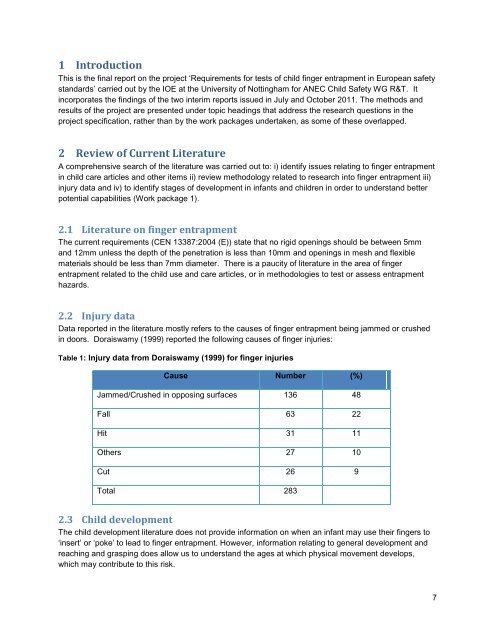Requirements for finger entrapment in European safety ... - ANEC
Requirements for finger entrapment in European safety ... - ANEC
Requirements for finger entrapment in European safety ... - ANEC
You also want an ePaper? Increase the reach of your titles
YUMPU automatically turns print PDFs into web optimized ePapers that Google loves.
1 Introduction<br />
This is the f<strong>in</strong>al report on the project ‘<strong>Requirements</strong> <strong>for</strong> tests of child <strong>f<strong>in</strong>ger</strong> <strong>entrapment</strong> <strong>in</strong> <strong>European</strong> <strong>safety</strong><br />
standards’ carried out by the IOE at the University of Nott<strong>in</strong>gham <strong>for</strong> <strong>ANEC</strong> Child Safety WG R&T. It<br />
<strong>in</strong>corporates the f<strong>in</strong>d<strong>in</strong>gs of the two <strong>in</strong>terim reports issued <strong>in</strong> July and October 2011. The methods and<br />
results of the project are presented under topic head<strong>in</strong>gs that address the research questions <strong>in</strong> the<br />
project specification, rather than by the work packages undertaken, as some of these overlapped.<br />
2 Review of Current Literature<br />
A comprehensive search of the literature was carried out to: i) identify issues relat<strong>in</strong>g to <strong>f<strong>in</strong>ger</strong> <strong>entrapment</strong><br />
<strong>in</strong> child care articles and other items ii) review methodology related to research <strong>in</strong>to <strong>f<strong>in</strong>ger</strong> <strong>entrapment</strong> iii)<br />
<strong>in</strong>jury data and iv) to identify stages of development <strong>in</strong> <strong>in</strong>fants and children <strong>in</strong> order to understand better<br />
potential capabilities (Work package 1).<br />
2.1 Literature on <strong>f<strong>in</strong>ger</strong> <strong>entrapment</strong><br />
The current requirements (CEN 13387:2004 (E)) state that no rigid open<strong>in</strong>gs should be between 5mm<br />
and 12mm unless the depth of the penetration is less than 10mm and open<strong>in</strong>gs <strong>in</strong> mesh and flexible<br />
materials should be less than 7mm diameter. There is a paucity of literature <strong>in</strong> the area of <strong>f<strong>in</strong>ger</strong><br />
<strong>entrapment</strong> related to the child use and care articles, or <strong>in</strong> methodologies to test or assess <strong>entrapment</strong><br />
hazards.<br />
2.2 Injury data<br />
Data reported <strong>in</strong> the literature mostly refers to the causes of <strong>f<strong>in</strong>ger</strong> <strong>entrapment</strong> be<strong>in</strong>g jammed or crushed<br />
<strong>in</strong> doors. Doraiswamy (1999) reported the follow<strong>in</strong>g causes of <strong>f<strong>in</strong>ger</strong> <strong>in</strong>juries:<br />
Table 1: Injury data from Doraiswamy (1999) <strong>for</strong> <strong>f<strong>in</strong>ger</strong> <strong>in</strong>juries<br />
Cause Number (%)<br />
Jammed/Crushed <strong>in</strong> oppos<strong>in</strong>g surfaces 136 48<br />
Fall 63 22<br />
Hit 31 11<br />
Others 27 10<br />
Cut 26 9<br />
Total 283<br />
2.3 Child development<br />
The child development literature does not provide <strong>in</strong><strong>for</strong>mation on when an <strong>in</strong>fant may use their <strong>f<strong>in</strong>ger</strong>s to<br />
‘<strong>in</strong>sert’ or ‘poke’ to lead to <strong>f<strong>in</strong>ger</strong> <strong>entrapment</strong>. However, <strong>in</strong><strong>for</strong>mation relat<strong>in</strong>g to general development and<br />
reach<strong>in</strong>g and grasp<strong>in</strong>g does allow us to understand the ages at which physical movement develops,<br />
which may contribute to this risk.<br />
7
















